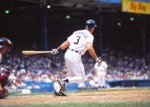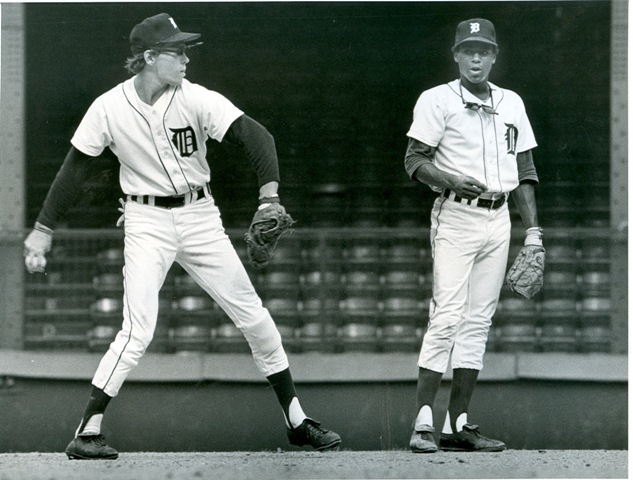 Should Alan Trammell be enshrined in the Baseball Hall of Fame? In short, yes. Below is a statistical look at how he compares to Hall of Fame averages both as his position and overall.
Should Alan Trammell be enshrined in the Baseball Hall of Fame? In short, yes. Below is a statistical look at how he compares to Hall of Fame averages both as his position and overall.
The chart starts with the averages of the 22 shortstops already enshrined in the Hall of Fame. This group represents the 22 players who were elected as players only, and were enshrined because of their MLB playing careers. The averages include Ernie Banks’ numbers, Banks ended up playing more games at first than short however seven of his eight peak seasons were played primarily at shortstop.
An interesting note about this group of 22, 16 of them started their careers before 1945. 10 of those players, started before 1925. Modern shortstops are under represented in the Hall of Fame, that’s one of the reasons I think Trammell is deserving.
Next on the chart are a look at Trammell’s career numbers.
Trammell exceeds the Hall of Fame standard in bWAR (Baseball-Reference) and meets them in fWAR (FanGraphs). He also exceeds standards in OPS+ and wRC+. Trammell’s numbers as a whole are remarkably similar to the Hall of Fame averages across the board.
- Next on the chart are the averages for every position player enshrined in the Hall of Fame. Again, this group of players are the Hall of Famers who were elected as players only, for their MLB career.
Trammell’s career bWAR of 67.1 exceeds the overall Hall of Fame standard of 63.2. Trammell’s traditional counting numbers fall short, however most middle infielders fall short statistically when they are compared to first basemen and outfielders.
The last set of numbers on the chart above are the Hall of Fame averages for players who started their career from 1945-present. I like looking at these numbers more than the overall averages because of how much the game has changed over the past 140 years. Comparing Trammell (or any modern player) to the players who played in a segregated league when the game was still developing, isn’t ideal.
In addition to the numbers listed above, Trammell also exceeds standards in C-WAR. C-WAR is a Hall of Fame monitoring system I created using career and peak WAR. C-WAR is the career WAR(P) totals from Baseball-Reference, FanGraphs, and Baseball Prospectus added up and averaged out, plus an eight year peak (five best years in a row, plus 3 best additional years) from Baseball-Reference. Click here for more information on C-WAR.
The average C-WAR line for a Hall of Fame shortstop is: 64.9 career average/43.4 peak/108.3 C-WAR. Trammell’s line looks like this 63.4 career average/46.7 peak/110.1 C-WAR. Trammel’s 110.1 C-WAR is a higher number posted by ten shortstops enshrined in the Hall, including Pee Wee Reese, and Joe Tinker.
Trammell’s OPS+ (110) and wRC+ (111) come close to the numbers Robin Yount posted (115) and (114), however according to UZR, Trammell bested Yount by 123 runs saved over their careers.
Trammell is tied for 11th (with Larkin) in career bWAR for shortstops, ahead of Hall of Famers that include Wallace, Reese, and Cronin. From 1980-1989 Trammell’s bWAR of 50.7 ranked 5th in all of baseball, second among shortstops to Robin Yount at 53.2. Trammell’s 50.7 WAR during the 80’s topped Hall of Famers Ozzie Smith (49.9), Cal Ripken (48.3), George Brett (45.8), and Andre Dawson (45.0).
Trammell had six seasons with a bWAR of 5 or more, that includes 1987 when he posted a WAR of 8. He also had six full seasons with an OPS+ of 120 or higher, to put that number in perspective that ties him with Cal Ripken. Barry Larkin had five, Yount had four (at short).
I understand that looking at the overall Hall of Fame averages isn’t a perfect mechanism. Different eras greatly skew the averages, as do some of the undeserving members at each position. Comparing Trammell to Bobby Wallace doesn’t make much sense, but comparing him to Yount, Larkin, and Ozzie Smith does. Below is a look at how Trammell’s career numbers match up against those three.
They all have similar career value, yet all three were very different players. Yount played half of his career in the outfield, Smith was the best defensive shortstop ever to play but a below average hitter, and Larkin battled injuries throughout his career.
For me the interesting comparison here is with Ozzie Smith. Trammell was not the defender that Smith was, however he crushes Smith in every offensive category. Their career WAR numbers are almost identical and so is their peak value. Smith got elected his first year on the ballot with over 90% of the vote, Trammell is still languishing on the ballot having yet to receive even half of the 75% needed for election.
Trammell may not have been the best shortstop ever to play, but that’s not what the Hall of Fame is. His traditional counting numbers (hits, HR, XBH, TB) meet or exceed Hall of Fame standards, and new metrics like WAR help to paint a more accurate picture of his true value.
Trammell was a better player than at least seven shortstops enshrined in the Hall of Fame. He did lots of things very well, but never dominated in any one particular area. That’s one of the text book ways a player, even a Hall of Fame caliber player, can spend his entire career being underrated or undervalued. He played in the shadows of his Hall of Fame contemporaries Ripken, Yount, and Smith. He may not have been as good as Ripken or Yount, but he deserves his do and should be enshrined.
One other note, because the numbers used to the compile the Hall of Fame averages are MLB stats only, it makes it impossible for me to include players who played exclusively in the Negro Leagues. Nothing has diluted stats and the integrity of the game like the exclusion of black players for over fifty years. While I can’t include them with these averages, I encourage you to visit the websites for the Negro Leagues Baseball Museum, and the National Baseball Hall of Fame to find out more about the many great players who were shamefully excluded from the game because of the color of their skin.
Many thanks to the incredibly smart people who work at Baseball-Reference, and FanGraphs, without their tireless efforts to improve and maintain their sites and information none of this research would be possible. It’s also worth noting that sometimes FanGraphs and Baseball-Reference have slightly different numbers for the same player. For example, FanGraphs has Willie Mays with 12,493 plate appearances, Baseball-Reference has him at 12,496. These slight differences are common with historical players, the differences aren’t enough to skew the averages but it’s worth mentioning that the statistics represented in the chart above were compiled using data mostly from Baseball-Reference.
Follow Ross on twitter @Rosscarey
Images used courtesy of the Detroit Tigers
Originally posted 11/13/12

Alan Trammel clearly deserves to be in HoF, he even won a WS MVP, 6 time AS, 3 time SS award, and comeback player award. That is HoF.
Agreed. The difference between Trammell and Smith is negligible. The VC will eventually put him in.
I keep vacillating on Trammell, and have him in one day and out the next. My problems with his candidacy come down to two issues: First, he was a good, not a great hitter. His career OPS+ is only ten percent above league average, even though he played in an excellent park for hitters throughout most of his carer. And, all the metrics I’ve seen indicate he was what I remember him as as being, a sure-handed defender with average, or even slighly below average, range. His defensive numbers just aren’t that impressive. Unless I see something that persuades me the defensive metrics are wrong, I can’t see voting for him.
I don’t think I can point to any one defensive metric with Trammel as the reason why I would put him in, but I think he was an above average defender and most metrics show that. His offense isn’t great compared to the average Hall of Famer, but compared to the average Hall of Fame shortstop, he meets or exceeds several traditional and advanced numbers including AVG/OBP/SLG, OPS+, wRC+, home runs, and runs. He’s too close to Yount and Larkin for me to justify keeping him out.